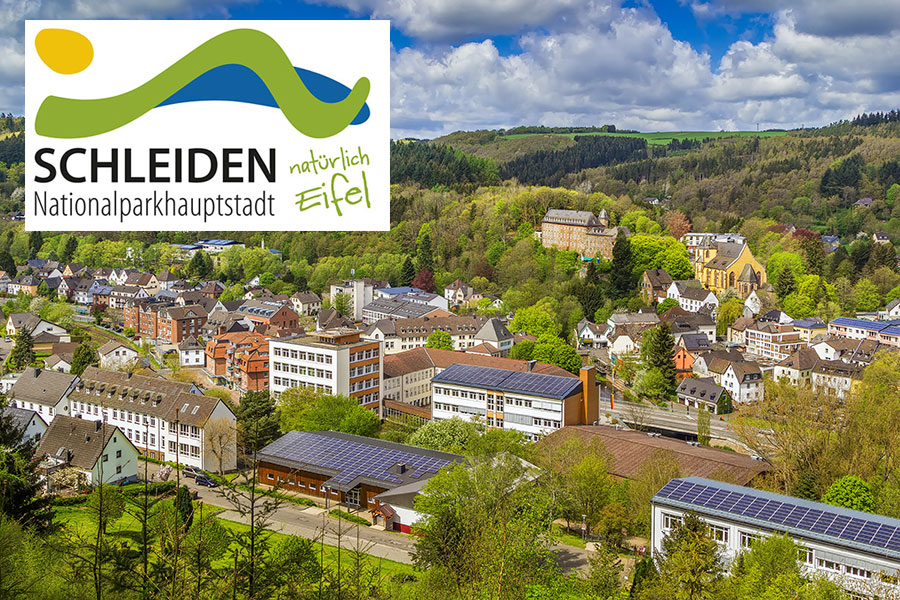City of Schleiden
The former district town of Schleiden in the romantic Oleftal valley is located directly at the Eifel National Park.
The town of Schleiden is known for its wooded and natural surroundings and is a popular starting point for hikes and excursions to the Eifel lakes, the Rur valley and the Hocheifel winter sports area.
Worth seeing are, among others, the “Schleiden Castle”, a former castle that was first mentioned in a document in 1188 and today serves as a residence for senior citizens, as well as the “Castle Church”, consecrated in 1230, with the famous “King’s Organ” from 1770 and colourful Renaissance windows.
The district of Olef, with its historic centre, still offers a largely self-contained picture of a historic residential location. The late Gothic parish church and several two-storey half-timbered buildings dominate the picture.
High Fens Nature Park - Eifel
The nature park, which covers an area of around 2,700 square kilometres, extends over parts of North Rhine-Westphalia, Rhineland-Palatinate and eastern Belgium. The high moorland in the Belgian “Hohe Venn” is just as much a part of the diverse natural landscapes as the rivers, streams, lakes and reservoirs, as are the Kalkeifel and the mountain ranges of the Hocheifel and the foothills of the Vulkaneifel. In the middle of the nature park is the Eifel National Park, the only national park in North Rhine-Westphalia.
Time and again you come across witnesses to history, such as Stone Age caves, Roman buildings, over 100 castles, palaces and monasteries, or the now ecologically valuable remains of the West Wall.
The impressive natural landscape with its colourful flora and fauna is the basis for an active and relaxing holiday in the Eifel.
Eifel National Park
In the Eifel National Park, the only national park in North Rhine-Westphalia, the motto “Let nature be nature” applies to an area of 110 square kilometres. Here, nature can find its way back to its very own old cycle of becoming and passing away.
Nevertheless, nature can be experienced on around 240 kilometres of hiking trails, some of which are designated as parallel cycle or bridle paths. And flora and fauna can be explored on about 50 kilometres of designated trails of the former Vogelsang military training area, which is part of the national park. Here, for example, red deer can be observed in broad daylight.
In the Eifel National Park you can hike through romantic stream valleys, impressive beech forests and, in spring, colourful flower carpets. Here you will follow the call of the black woodpecker, one of over 900 endangered animal and plant species, to enter the primeval forests of tomorrow.
You will enjoy unique views of the three reservoirs in the national park region and experience the fascination of pristine wilderness in the midst of a landscape of forest and water.
Other destinations
NS-Ordensburg Vogelsang
The former Nazi Ordensburg Vogelsang is a complex of buildings erected by the National Socialists above the Urft reservoir and served the NSDAP as a training centre for the next generation of leaders.
After the party conference buildings in Nuremberg, the listed part of the buildings is the largest architectural legacy of National Socialism in Germany.
In 2006, the site was opened to the public and a visitor centre was established. Parts of the surrounding areas have been made accessible by hiking trails.
Urft Valley Dam
The Urft reservoir, built between 1900 and 1905, is the oldest reservoir in the Eifel. The island of Krummenauel lies in the wooded lake and three peninsulas jut into the lake, which can also be reached on foot when the water level is favourable.
The Urftseerandweg always leads along the Urft, which has carved its riverbed through the Eifel. From the Schleiden district of Gemünd-Malsbenden, hikers and cyclists can explore this wonderful hiking and cycling trail. The route is about 12 km long and leads through an almost untouched landscape.






